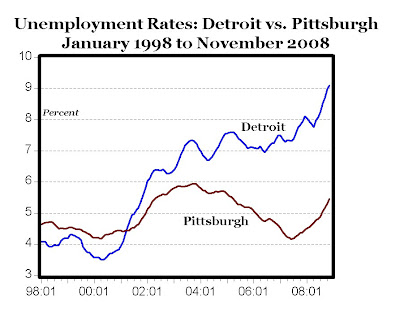 PITTSBURGH (NY TIMES) — This is what life in one American city looks like after an industrial collapse: Unemployment is 5.5%, far below the national average (see chart above). While housing prices sank nearly everywhere in the last year, they rose here. Wages are also up. Foreclosures are comparatively uncommon.
PITTSBURGH (NY TIMES) — This is what life in one American city looks like after an industrial collapse: Unemployment is 5.5%, far below the national average (see chart above). While housing prices sank nearly everywhere in the last year, they rose here. Wages are also up. Foreclosures are comparatively uncommon.A generation ago, the steel industry that built Pittsburgh and still dominated its economy entered its death throes. In the early 1980s, the city was being talked about the way Detroit is now. Its very survival was in question. Deindustrialization in Pittsburgh was a protracted and painful experience. Yet it set the stage for an economy that is the envy of many recession-plagued communities, particularly those where the automobile industry is struggling for its life.
“If people are looking for hope, it’s here,” said Sabina Deitrick, an urban studies expert at the University of Pittsburgh. “You can have a decent economy over a long period of restructuring.”
Yet the semisweet spot that Pittsburgh finds itself in was never inevitable. As recently as 2000, it had a higher unemployment rate than Detroit or Cleveland (see chart below). Just as Michigan has traditionally put all its chips on the auto industry, it took Pittsburgh a long time to come to terms with the end of the steel era.

In a previous CD post, I documented the shift of Flint, Michigan (once the epicenter of both the UAW and GM) from a undiversified manufacturing-intensive, one-company town to a service sector economy. If a transition can happen in Pittsburgh and Flint, it could realistically happen anywhere.






No comments:
Post a Comment